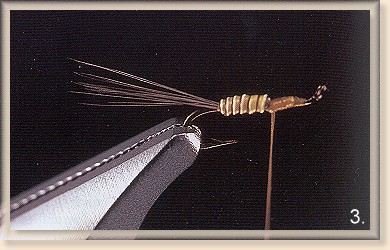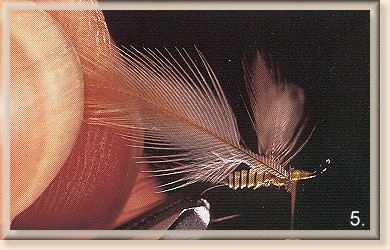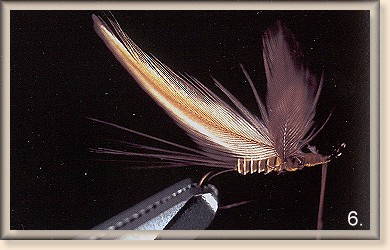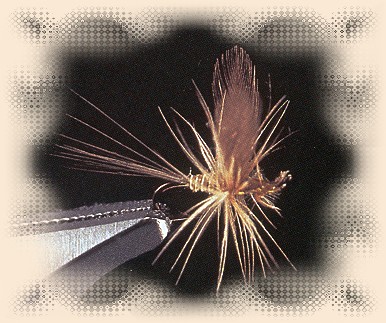Stiff, expensive hackle simply isn't needed on small
flies fished in skinny water or on glass-smooth runs
near shady banks. In fact, hackling flies in the
traditional manner for these situations may inhibit
success. I've been hackling flies for this kind of
fishing with only two turns of hen hackle for the past
four or five years. Some of my #18 and smaller Baetis
are hackled with two turns of cream hen hackle, as are
all of my Trico Duns and Black Midge Emergers. I clip
the hackle flush with the bottom of the thorax on these
flies. Flotation isn't a problem due to today's modern
dry-fly dressing. The hen hackle fibers are a little
thicker - which I think more accurately matches the
diameter of the insects' legs - and since the fibers of
a hen hackle are softer, there's some movement. I've
noticed that many insects' legs move a little as they
struggle for balance while drifting downstream. In
consideration of these observations, I offer the following
patterns, which have made my experiences fishing skinny
water much more successful and enjoyable.
Materials List Olive Quill Baetis Dun:
Hook: Your favorite dry-fly hook, #20 through 24.
Thread: Light green 8/0.
Tail: Medium dun spade hackle fibers, length to
equal hook length.
Body: One stripped and light green dyed rooster neck
quill.
Wings: Pair of medium dun hen hackle tips.
Hackle: Two turns of light ginger or cream hen hackle.
Instructions - Olive Quill Baetis Dun:
1. Attach the tying thread at midshank and wrap
to the beginning of the bend, taking two turns of
thread on top of the last turn of thread to create
a tiny thread bump.

2. Clip five or six spade hackle fibers and tie
them onto the hook immediately in front of the
tiny thread bump to cock the tails up slightly.
Lash the tailing butts to the hook shank to
within three hook-eye spaces of the hook eye, lift the
butts, and clip them off. This spot will become
the shoulder of the body.
3. Select one stripped and light green dyed rooster
neck hackle quill and clip off the tip at a point where
the diameter of the remaining quill will be equal to
the diameter of the hook, tailing butts, and thread.
Place the clipped end of the quill on the hook to be
lined up with the clipped tailing butts and lash it
to the hook by wrapping the tying thread toward the
hook bend.

4. Bring the tying thread forward to the shoulder
and wrap the quill forward in tightly nested wraps.
Tie down the quill butt on the top of the hook and
clip off the excess. Cover the clipped butt with
tying thread until it's smooth.

5. Select two medium dun hackle tips, whose width
should equal the hook gap. Measure them to be as
long as the entire hook plus one hook-eye space and
clip off the butts. Place the wings on the hook (tips
to the rear), and tie them on the hook immediately in
front of the shoulder. Figure-eight the tying thread
through the wings to seperate, leaving the tying thread
hanging immediately in front of the wings.

6. Select one light ginger or cream hen hackle feather from
near the tip of the neck. The hackle fiber length should
be one and a half times the hook-gap distance.

7. Trim the maraboulike fibers from near the butt of the
feather and tie the butt to the hook immediately in front
of the wings, dull-side up.

8. Attach your hackle pliers to the tip of the feather
and make the first turn of hackle straight away from you
down in front of the far wing and under the hook to come
around behind the wings.

The hackle feather should twist, making the hackle
fibers point to the rear of the fly. Continue wrapping
the backle by bringing the feather down on the far side
of the hook and forward under the hook to come up in
front of the wings.

The feather will twist again, causing the hackle fibers to
lean forward. Take one complete turn of hackle in front
on the wings, tie down the tip, and clip away the excess.
9. Whip-finish, trim all the hackle from the bottom of
the fly even with the thorax area, and apply a tiny drop
of head lacquer to the head.

Delicate Flies for Skinny Water
Keep in mind that trout couldn't care less whether
or not you like to tie tiny flies. When #24 BWOs are on
the water, that's all they're interest in eating. The
difference between the length of a #24 hook and a #26 hook
is only about 2/1000 inch. I fished the South Platte
recently with Mike Clark during a hatch of tiny BWOs.
I cast a #24 Olive Quill Dun to a rising fish for nearly
half an hour without success. I was hesitant to change
flies because I had been catching fish on the same fly.
There were still duns on the water, and I could see my
trout eat them. In desperation, I tied on a tiny #26 - and
the trout ate it on the first cast. It was only then that
I netted the water and discovered that the hatch had changed.
Remember what I said earlier about "iron-clad" ideas? I was
so convinced that I had on the right-sized fly that I didn't
bother to check.
Here's a tip for fishing tiny flies: Tie on a #16 Blond
Caddis, then tie an 18-inch dropper off the bend of the
Caddis and tie a tiny fly to the end of the dropper. The
larger Caddis will help you "find" your tiny fly. You may
even discover that one or two trout will attack your Caddis.
Always use 7X when fishing any fly smaller than a #20 so
the fly will float more freely.
~ AK
Credits:
Excerpt from Advanced Fly Tying, by
A.K. Best, published by The Lyons Press. Thanks AK!



